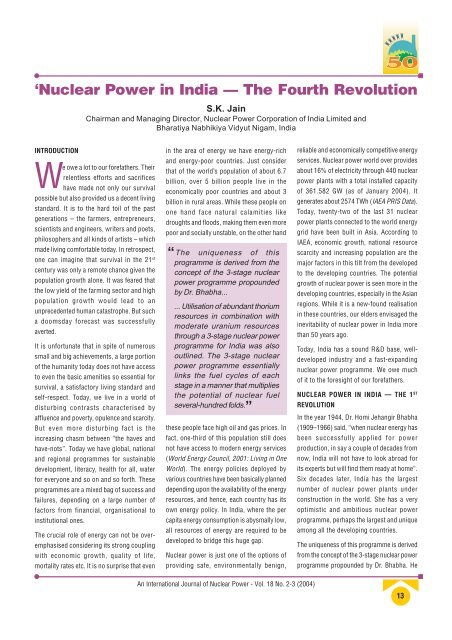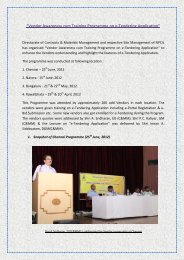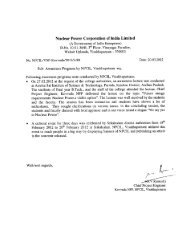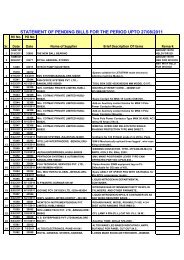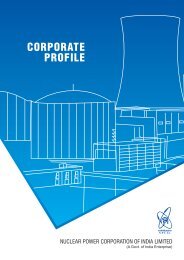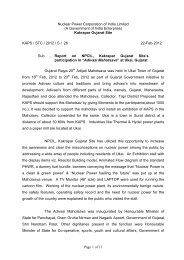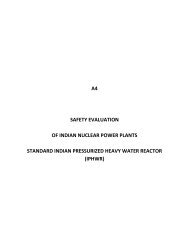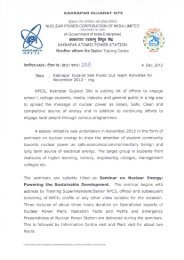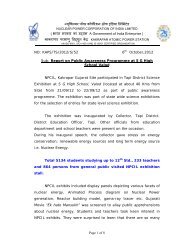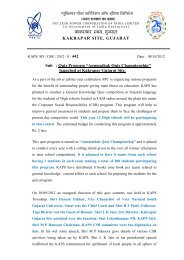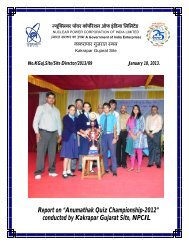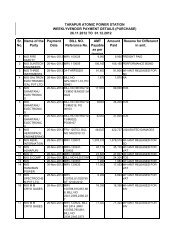'Nuclear Power in India — The Fourth Revolution
'Nuclear Power in India — The Fourth Revolution
'Nuclear Power in India — The Fourth Revolution
Create successful ePaper yourself
Turn your PDF publications into a flip-book with our unique Google optimized e-Paper software.
‘Nuclear <strong>Power</strong> <strong>in</strong> <strong>India</strong> <strong>—</strong> <strong>The</strong> <strong>Fourth</strong> <strong>Revolution</strong><br />
INTRODUCTION<br />
S.K. Ja<strong>in</strong><br />
Chairman and Manag<strong>in</strong>g Director, Nuclear <strong>Power</strong> Corporation of <strong>India</strong> Limited and<br />
Bharatiya Nabhikiya Vidyut Nigam, <strong>India</strong><br />
We owe a lot to our forefathers. <strong>The</strong>ir<br />
relentless efforts and sacrifices<br />
have made not only our survival<br />
possible but also provided us a decent liv<strong>in</strong>g<br />
standard. It is to the hard toil of the past<br />
generations – the farmers, entrepreneurs,<br />
scientists and eng<strong>in</strong>eers, writers and poets,<br />
philosophers and all k<strong>in</strong>ds of artists – which<br />
made liv<strong>in</strong>g comfortable today. In retrospect,<br />
one can imag<strong>in</strong>e that survival <strong>in</strong> the 21st century was only a remote chance given the<br />
population growth alone. It was feared that<br />
the low yield of the farm<strong>in</strong>g sector and high<br />
population growth would lead to an<br />
unprecedented human catastrophe. But such<br />
a doomsday forecast was successfully<br />
averted.<br />
It is unfortunate that <strong>in</strong> spite of numerous<br />
small and big achievements, a large portion<br />
of the humanity today does not have access<br />
to even the basic amenities so essential for<br />
survival, a satisfactory liv<strong>in</strong>g standard and<br />
self-respect. Today, we live <strong>in</strong> a world of<br />
disturb<strong>in</strong>g contrasts characterised by<br />
affluence and poverty, opulence and scarcity.<br />
But even more disturb<strong>in</strong>g fact is the<br />
<strong>in</strong>creas<strong>in</strong>g chasm between “the haves and<br />
have-nots”. Today we have global, national<br />
and regional programmes for susta<strong>in</strong>able<br />
development, literacy, health for all, water<br />
for everyone and so on and so forth. <strong>The</strong>se<br />
programmes are a mixed bag of success and<br />
failures, depend<strong>in</strong>g on a large number of<br />
factors from f<strong>in</strong>ancial, organisational to<br />
<strong>in</strong>stitutional ones.<br />
<strong>The</strong> crucial role of energy can not be overemphasised<br />
consider<strong>in</strong>g its strong coupl<strong>in</strong>g<br />
with economic growth, quality of life,<br />
mortality rates etc. It is no surprise that even<br />
<strong>in</strong> the area of energy we have energy-rich<br />
and energy-poor countries. Just consider<br />
that of the world’s population of about 6.7<br />
billion, over 5 billion people live <strong>in</strong> the<br />
economically poor countries and about 3<br />
billion <strong>in</strong> rural areas. While these people on<br />
one hand face natural calamities like<br />
droughts and floods, mak<strong>in</strong>g them even more<br />
poor and socially unstable, on the other hand<br />
“<strong>The</strong> uniqueness of this<br />
programme is derived from the<br />
concept of the 3-stage nuclear<br />
power programme propounded<br />
by Dr. Bhabha...<br />
... Utilisation of abundant thorium<br />
resources <strong>in</strong> comb<strong>in</strong>ation with<br />
moderate uranium resources<br />
through a 3-stage nuclear power<br />
programme for <strong>India</strong> was also<br />
outl<strong>in</strong>ed. <strong>The</strong> 3-stage nuclear<br />
power programme essentially<br />
l<strong>in</strong>ks the fuel cycles of each<br />
stage <strong>in</strong> a manner that multiplies<br />
the potential of nuclear fuel<br />
several-hundred folds.”<br />
these people face high oil and gas prices. In<br />
fact, one-third of this population still does<br />
not have access to modern energy services<br />
(World Energy Council, 2001: Liv<strong>in</strong>g <strong>in</strong> One<br />
World). <strong>The</strong> energy policies deployed by<br />
various countries have been basically planned<br />
depend<strong>in</strong>g upon the availability of the energy<br />
resources, and hence, each country has its<br />
own energy policy. In <strong>India</strong>, where the per<br />
capita energy consumption is abysmally low,<br />
all resources of energy are required to be<br />
developed to bridge this huge gap.<br />
Nuclear power is just one of the options of<br />
provid<strong>in</strong>g safe, environmentally benign,<br />
An International Journal of Nuclear <strong>Power</strong> - Vol. 18 No. 2-3 (2004)<br />
reliable and economically competitive energy<br />
services. Nuclear power world over provides<br />
about 16% of electricity through 440 nuclear<br />
power plants with a total <strong>in</strong>stalled capacity<br />
of 361.582 GW (as of January 2004). It<br />
generates about 2574 TWh (IAEA PRIS Data).<br />
Today, twenty-two of the last 31 nuclear<br />
power plants connected to the world energy<br />
grid have been built <strong>in</strong> Asia. Accord<strong>in</strong>g to<br />
IAEA, economic growth, national resource<br />
scarcity and <strong>in</strong>creas<strong>in</strong>g population are the<br />
major factors <strong>in</strong> this tilt from the developed<br />
to the develop<strong>in</strong>g countries. <strong>The</strong> potential<br />
growth of nuclear power is seen more <strong>in</strong> the<br />
develop<strong>in</strong>g countries, especially <strong>in</strong> the Asian<br />
regions. While it is a new-found realisation<br />
<strong>in</strong> these countries, our elders envisaged the<br />
<strong>in</strong>evitability of nuclear power <strong>in</strong> <strong>India</strong> more<br />
than 50 years ago.<br />
Today, <strong>India</strong> has a sound R&D base, welldeveloped<br />
<strong>in</strong>dustry and a fast-expand<strong>in</strong>g<br />
nuclear power programme. We owe much<br />
of it to the foresight of our forefathers.<br />
NUCLEAR POWER IN INDIA <strong>—</strong> THE 1ST REVOLUTION<br />
In the year 1944, Dr. Homi Jehangir Bhabha<br />
(1909–1966) said, “when nuclear energy has<br />
been successfully applied for power<br />
production, <strong>in</strong> say a couple of decades from<br />
now, <strong>India</strong> will not have to look abroad for<br />
its experts but will f<strong>in</strong>d them ready at home”.<br />
Six decades later, <strong>India</strong> has the largest<br />
number of nuclear power plants under<br />
construction <strong>in</strong> the world. She has a very<br />
optimistic and ambitious nuclear power<br />
programme, perhaps the largest and unique<br />
among all the develop<strong>in</strong>g countries.<br />
<strong>The</strong> uniqueness of this programme is derived<br />
from the concept of the 3-stage nuclear power<br />
programme propounded by Dr. Bhabha. He<br />
13
presented a paper, “the need for atomic<br />
energy <strong>in</strong> the under-developed countries” at<br />
the Second International Conference on the<br />
Peaceful Uses of Atomic Energy <strong>in</strong> Geneva<br />
<strong>in</strong> September 1958. Dr. Bhabha and Dr. N.B.<br />
Prasad presented another paper, “a study of<br />
the contribution of atomic energy to a power<br />
programme <strong>in</strong> <strong>India</strong>”. <strong>The</strong>se papers argued<br />
the importance of nuclear power <strong>in</strong> the<br />
develop<strong>in</strong>g countries – a fact be<strong>in</strong>g realised<br />
by these countries today. Utilisation of<br />
abundant thorium resources <strong>in</strong> comb<strong>in</strong>ation<br />
with moderate uranium resources through a<br />
3-stage nuclear power programme for <strong>India</strong><br />
was also outl<strong>in</strong>ed. <strong>The</strong> 3-stage nuclear power<br />
programme essentially l<strong>in</strong>ks the fuel cycles<br />
of each stage <strong>in</strong> a manner that multiplies the<br />
potential of nuclear fuel several-hundred<br />
folds.<br />
<strong>The</strong> research <strong>in</strong> nuclear sciences was<br />
<strong>in</strong>itiated even before <strong>India</strong>’s <strong>in</strong>dependence<br />
with the establishment of Tata Institute of<br />
Fundamental Research (TIFR), which was<br />
<strong>in</strong>augurated way back <strong>in</strong> December 1945.<br />
“A major challenge before the<br />
nuclear establishment <strong>in</strong> <strong>India</strong> <strong>in</strong><br />
the early days was to develop<br />
an <strong>in</strong>digenous <strong>in</strong>dustry capable<br />
of meet<strong>in</strong>g the requirements of<br />
the nuclear power <strong>in</strong>dustry.”<br />
Atomic Energy Establishment Trombay<br />
(AEET) was set up <strong>in</strong> 1954 as the nodal <strong>in</strong>house<br />
R&D facility for <strong>India</strong>’s nuclear power<br />
programme. <strong>The</strong> AEET was renamed Bhabha<br />
Atomic Research Centre (BARC) <strong>in</strong> January<br />
1967 after Dr. Homi J. Bhabha, the father of<br />
<strong>India</strong>n nuclear power programme. Today,<br />
these facilities have grown manifold <strong>in</strong>to<br />
highly successful multi-discipl<strong>in</strong>ary centres<br />
of technology with<strong>in</strong> the Department of<br />
Atomic Energy (DAE) such as Bhabha Atomic<br />
Research Centre (BARC), Indira Gandhi<br />
Centre for Atomic Research (IGCAR),<br />
Uranium Corporation of <strong>India</strong> Ltd. (UCIL),<br />
Atomic M<strong>in</strong>erals Division (AMD), <strong>India</strong>n Rare<br />
14<br />
Earths Ltd. (IRE), Nuclear Fuels Complex<br />
(NFC), Heavy Water Board (HWB),<br />
Electronics Corporation of <strong>India</strong> Ltd. (ECIL),<br />
to name just a few. A total mastery of all the<br />
technologies <strong>in</strong>volved <strong>in</strong> the entire nuclear<br />
fuel cycle has been one of our country’s major<br />
achievements.<br />
As a first step to establish the techno-economic<br />
feasibility of nuclear power plants <strong>in</strong> <strong>India</strong> and<br />
to operate and ma<strong>in</strong>ta<strong>in</strong> the nuclear power<br />
stations <strong>in</strong> regional grid system, two reactors<br />
were imported from the USA. <strong>The</strong>se boil<strong>in</strong>g<br />
water reactors (BWRs) were supplied by<br />
General Electric Company, USA on turnkey<br />
basis and were commissioned at Tarapur, about<br />
a hundred kilometres away from Mumbai.<br />
<strong>The</strong>se reactors have served their <strong>in</strong>tended<br />
purpose well and cont<strong>in</strong>ue to be <strong>in</strong> operation<br />
after about 35 years of their commission<strong>in</strong>g.<br />
<strong>The</strong>se reactors are also source of cheap<br />
electricity at 83 paise per unit.<br />
NUCLEAR POWER IN INDIA <strong>—</strong> THE 2ND REVOLUTION<br />
A major milestone towards the long-term<br />
nuclear power programme <strong>in</strong> <strong>India</strong> was<br />
achieved with the commission<strong>in</strong>g of <strong>India</strong>’s<br />
first PHWRs at Rajasthan (RAPS-1&2). In<br />
fact, work on these two units was taken up<br />
<strong>in</strong> parallel with the commission<strong>in</strong>g of the<br />
two units at Tarapur (TAPS-1&2). <strong>The</strong><br />
Douglas Po<strong>in</strong>t <strong>in</strong> Canada was a prototype<br />
PHWR on which the design of RAPS-1 was<br />
based upon. <strong>The</strong> Rajasthan plant was set up<br />
<strong>in</strong> technical collaboration with Atomic<br />
Energy Canada Limited (AECL). <strong>India</strong>n<br />
eng<strong>in</strong>eers and scientists made significant<br />
contributions <strong>in</strong> the construction and<br />
commission<strong>in</strong>g of this plant. Even <strong>in</strong> unit-1<br />
(RAPS-1) some equipment and components<br />
were manufactured <strong>in</strong> <strong>India</strong>. In the second<br />
unit, the fabrication of large, critical nuclear<br />
components like end-shields, steam<br />
generators, calandria etc. was taken up<br />
<strong>in</strong>digenously.<br />
It may be noted that when nuclear power<br />
programme was shap<strong>in</strong>g up <strong>in</strong> <strong>India</strong> <strong>in</strong> 1960s<br />
and early 1970s, the <strong>India</strong>n <strong>in</strong>dustry was<br />
nascent. Some small and medium-size<br />
thermal power stations, some fertiliser and<br />
cement kilns, boiler drums and simple<br />
chemical reactors were the k<strong>in</strong>d of<br />
manufactur<strong>in</strong>g and fabrication jobs<br />
undertaken by the <strong>India</strong>n <strong>in</strong>dustry at that time.<br />
<strong>The</strong> <strong>in</strong>dustry was new to the fabrication<br />
techniques and exact<strong>in</strong>g code standards<br />
requirements for nuclear components like<br />
calandria, end-shields, steam generators,<br />
etc. Even on the conventional side,<br />
equipment like turb<strong>in</strong>es, generators, pumps<br />
etc. required <strong>in</strong> nuclear power plants were<br />
of much larger size than those be<strong>in</strong>g<br />
manufactured <strong>in</strong> <strong>India</strong> then. It may be recalled<br />
that <strong>India</strong> had missed the <strong>in</strong>dustrial<br />
revolution that swept over the West. <strong>The</strong><br />
<strong>in</strong>dustry <strong>in</strong> the West was reap<strong>in</strong>g the benefits<br />
of <strong>in</strong>dustrial revolution when a newly<br />
<strong>in</strong>dependent <strong>India</strong> was struggl<strong>in</strong>g hard to<br />
overcome the problems of illiteracy and<br />
poverty. It will not be out of place to po<strong>in</strong>t<br />
out that <strong>in</strong> the West, the manufactur<strong>in</strong>g<br />
<strong>in</strong>dustry had already been well developed by<br />
the defence and aero-space projects. In fact,<br />
the earliest development of nuclear power <strong>in</strong><br />
the US was of PWRs for the propulsion of<br />
submar<strong>in</strong>es or the ‘war mach<strong>in</strong>es’ as they<br />
called them. On the contrary, <strong>in</strong> <strong>India</strong>, it was<br />
the technical specifications, quality<br />
requirements, as also the computational and<br />
analytical needs of nuclear power<br />
programme that have been <strong>in</strong>strumental <strong>in</strong><br />
the development of manufacturers, design<br />
consultants, constructors and to some extent<br />
even academic <strong>in</strong>stitutions. <strong>The</strong><br />
commission<strong>in</strong>g of RAPS-2 was entirely by<br />
the <strong>India</strong>n scientists and eng<strong>in</strong>eers when the<br />
Canadian cooperation was discont<strong>in</strong>ued <strong>in</strong><br />
1974.<br />
Propelled by the goal of self-reliance and<br />
driven by the need for self-sufficiency, we<br />
have always endeavoured to establish longterm<br />
partnerships with <strong>India</strong>n <strong>in</strong>dustry to<br />
meet our requirements for nuclear equipment
and components. From the very beg<strong>in</strong>n<strong>in</strong>g,<br />
our efforts have been directed at build<strong>in</strong>g an<br />
<strong>in</strong>dustrial base, which can support the<br />
str<strong>in</strong>gent requirements of quality demanded<br />
by the nuclear <strong>in</strong>dustry. Relentless pursuit<br />
of excellence <strong>in</strong> quality, reliability and safety<br />
has been the hallmark of our strategy. This<br />
has conditioned all our <strong>in</strong>teractions with<br />
<strong>in</strong>dustrial partners <strong>in</strong> develop<strong>in</strong>g a work<br />
culture which susta<strong>in</strong>s and promotes this<br />
effort.<br />
Also, Research and Development facilities<br />
were established <strong>in</strong> the various atomic<br />
energy establishments and these were freely<br />
accessible to our <strong>in</strong>dustrial partners <strong>in</strong> their<br />
efforts to meet nuclear requirements. In many<br />
cases, the <strong>in</strong>itial design and development<br />
activity was started <strong>in</strong> our laboratories and<br />
later passed on to the <strong>India</strong>n <strong>in</strong>dustry. Special<br />
test facilities were created for qualify<strong>in</strong>g<br />
products manufactured <strong>in</strong>digenously. Test<strong>in</strong>g<br />
of large primary heat transport (PHT) pumps<br />
and motors is a case <strong>in</strong> po<strong>in</strong>t. Facilities<br />
available for the qualification of electronic<br />
components, reliability analysis, etc. are<br />
extensively used. <strong>The</strong>re has been<br />
considerable <strong>in</strong>teraction <strong>in</strong> the field of<br />
metallurgy for material evaluation and<br />
qualification also.<br />
Large reactor components like calandria and<br />
end-shield were required to be fabricated<br />
and precision-mach<strong>in</strong>ed. Eng<strong>in</strong>eers from<br />
<strong>India</strong>n <strong>in</strong>dustries, the erstwhile <strong>Power</strong><br />
Project Eng<strong>in</strong>eer<strong>in</strong>g Division (now NPCIL)<br />
and BARC jo<strong>in</strong>tly took up this challeng<strong>in</strong>g<br />
task. Handl<strong>in</strong>g and precision-mach<strong>in</strong><strong>in</strong>g of<br />
such large components was a new<br />
experience.<br />
Develop<strong>in</strong>g manufactur<strong>in</strong>g facilities for<br />
coolant channel components made from<br />
zirconium alloys was one of the most<br />
challeng<strong>in</strong>g tasks. DAE decided to develop<br />
<strong>in</strong>-house facilities for this purpose and the<br />
task was entrusted to Nuclear Fuel Complex<br />
(NFC), Hyderabad. <strong>The</strong> quality requirements<br />
for these products are very str<strong>in</strong>gent. <strong>The</strong><br />
chemical composition is required to be<br />
controlled at various stages. <strong>The</strong> material<br />
properties of the end products are <strong>in</strong>fluenced<br />
by the manufactur<strong>in</strong>g processes and thus<br />
control of manufactur<strong>in</strong>g processes at each<br />
stage is important. NFC has successfully met<br />
the challenge and supplied these coolant<br />
channel components for all the PHWR units<br />
except the first one at RAPS. <strong>The</strong> complete<br />
manufactur<strong>in</strong>g cycle of these tubes has been<br />
evolved at NFC.<br />
A major challenge before the nuclear<br />
establishment <strong>in</strong> <strong>India</strong> <strong>in</strong> the early days was to<br />
develop an <strong>in</strong>digenous <strong>in</strong>dustry capable of<br />
meet<strong>in</strong>g the requirements of the nuclear power<br />
“Look<strong>in</strong>g ahead, it appears that<br />
we need to further f<strong>in</strong>e-tune our<br />
project management strategies<br />
and upgrade them further to<br />
achieve a gestation period of 4½<br />
to 4 years for 220 MWe units and<br />
5 years for 540 / 700 MWe units.<br />
This will require meticulous<br />
plann<strong>in</strong>g, fail-proof strategies and<br />
dedicated efforts by one and all.”<br />
<strong>in</strong>dustry. <strong>The</strong> <strong>in</strong>digenous content <strong>in</strong> RAPS-1<br />
was only about 55%, which <strong>in</strong>creased to about<br />
75% <strong>in</strong> RAPS-2. <strong>The</strong> construction work on<br />
the tw<strong>in</strong>-unit PHWR station at Kalpakkam<br />
commenced <strong>in</strong> early 1970. This plant, Madras<br />
Atomic <strong>Power</strong> Station (unit-1&2), had major<br />
modifications and upgradations over its<br />
predecessor at Rajasthan (RAPS-1&2).<br />
However for MAPS, the design, manufacture<br />
of components and equipment, construction<br />
of plant and its commission<strong>in</strong>g was entirely<br />
by the <strong>in</strong>digenous efforts. RAPS-1&2 and<br />
MAPS-1&2 laid the foundation of the first the<br />
stage of <strong>India</strong>’s 3-stage programme. <strong>The</strong>se<br />
units provided a very valuable experience and<br />
feedback <strong>in</strong> almost all fields of design,<br />
manufactur<strong>in</strong>g, construction, commission<strong>in</strong>g<br />
and operation. Several teeth<strong>in</strong>g problems were<br />
encountered and overcome successfully.<br />
An International Journal of Nuclear <strong>Power</strong> - Vol. 18 No. 2-3 (2004)<br />
NUCLEAR POWER IN INDIA <strong>—</strong> THE 3 RD<br />
REVOLUTION<br />
A decision was taken <strong>in</strong> the mid-1970s to<br />
standardise all future 220 MWe stations. <strong>The</strong><br />
design of the nuclear components required<br />
major modifications <strong>in</strong> l<strong>in</strong>e with then latest<br />
code requirements, to improve the reliability<br />
and safety. This design also required a higher<br />
order of quality, <strong>in</strong>spection and<br />
manufactur<strong>in</strong>g of the components as<br />
compared to Rajasthan-1&2 or Madras-1&2.<br />
Industry faced several technical problems<br />
while manufactur<strong>in</strong>g these components for<br />
<strong>India</strong>’s first standardised design. Narora <strong>in</strong><br />
UP was selected for sett<strong>in</strong>g up the first of the<br />
standardised units. A significant number of<br />
developmental works were carried out to<br />
meet the design requirements. With several<br />
complex technical problems, equipment for<br />
this design were f<strong>in</strong>ally made, establish<strong>in</strong>g<br />
<strong>India</strong>’s design and manufactur<strong>in</strong>g<br />
capabilities. It was found that with careful<br />
plann<strong>in</strong>g and resource mobilisation, it was<br />
possible to conta<strong>in</strong> delays. This experience<br />
was fully utilised at KAPS, which was set up<br />
<strong>in</strong> Gujarat State <strong>in</strong> 1980s. <strong>The</strong> design maturity<br />
at Kakrapar, short manufactur<strong>in</strong>g cycles and<br />
the use of better construction techniques and<br />
project management helped <strong>in</strong> cutt<strong>in</strong>g down<br />
the gestation period of the project. <strong>The</strong><br />
commission<strong>in</strong>g of Kakrapar was a major<br />
milestone <strong>in</strong> terms of consolidation of the<br />
experience ga<strong>in</strong>ed at the previous units.<br />
It was for the first time <strong>in</strong> the history of<br />
nuclear power <strong>in</strong> <strong>India</strong> that the construction<br />
of four units was taken up concurrently, two<br />
at Rajasthan (units-1&2) and two at Kaiga<br />
(unit-1&2). Additional modifications <strong>in</strong> the<br />
design were <strong>in</strong>corporated to keep pace with<br />
the evolv<strong>in</strong>g safety standards and practices,<br />
reliability and a speedy construction of these<br />
projects. <strong>The</strong> commission<strong>in</strong>g of these<br />
projects was completed <strong>in</strong> the year 2000 <strong>in</strong> a<br />
record time though there were some glitches<br />
<strong>in</strong> the beg<strong>in</strong>n<strong>in</strong>g. <strong>The</strong> total <strong>in</strong>stalled nuclear<br />
capacity now stood at 2720 MWe (currently<br />
15
at 2770 after EMCCR at MAPS-2). This phase<br />
marked the maturity of <strong>India</strong>n nuclear power<br />
progrmme.<br />
We have come a long way s<strong>in</strong>ce the turnkey<br />
project at Tarapur was set up <strong>in</strong> 1960s and a<br />
technology collaboration project at Rajasthan<br />
<strong>in</strong> 1970s. PHWRs of 220 MWe capacity have<br />
“Nuclear power is already<br />
economically competitive with<br />
coal-thermal away from coal<br />
pitheads. But with <strong>in</strong>crease <strong>in</strong><br />
unit-capacity size, reduction <strong>in</strong><br />
project gestation periods and<br />
safe and higher operation levels,<br />
it is our endeavour to make it<br />
competitive with coal-thermal<br />
even at coal pithead. This will<br />
open new bus<strong>in</strong>ess avenues at<br />
new locations for NPCIL. It also<br />
implies that nuclear power will<br />
emerge as one of the cheapest<br />
sources of electricity <strong>in</strong> the<br />
regions, which are away from<br />
coal-belts.”<br />
cont<strong>in</strong>ually evolved and today we have 12<br />
units operat<strong>in</strong>g at Rajasthan (RAPS 1-4),<br />
Madras (MAPS-1&2), Narora (NAPS 1&2),<br />
Kakrapar (KAPS-1&2) and Kaiga (KGS-<br />
1&2) besides the two BWRs at TAPS. Eight<br />
more units, two at Tarapur (TAPP-3&4) of<br />
540 MWe each, two at Kaiga (Kaiga-3&4) of<br />
220 MWe each, two at Kudankulam of 1000<br />
MWe each and two at Rajasthan (RAPP-<br />
5&6) of 220 MWe each are at various stages<br />
of construction.<br />
<strong>The</strong> design of 220 MWe PHWRs has now<br />
technologically, <strong>in</strong>dustrially and<br />
economically matured. We have launched the<br />
construction of the next generation of PHWR<br />
reactors of 540 MWe capacity at Tarapur<br />
(TAPP-3&4). <strong>The</strong> design has further been<br />
upgraded to 700 MWe capacity and <strong>in</strong> future<br />
such large-sized plants will be set up,<br />
provid<strong>in</strong>g economy of scales. In parellel, the<br />
Kudankulam nuclear power project (KKNPP),<br />
compris<strong>in</strong>g of two units of VVER, or PWR<br />
<strong>in</strong> Western terms, of 1000 MWe each, is be<strong>in</strong>g<br />
set up <strong>in</strong> collaboration with the Russian<br />
Federation as a nuclear capacity add-on<br />
venture. However, the entire construction,<br />
<strong>in</strong>clud<strong>in</strong>g that of the ma<strong>in</strong> plant build<strong>in</strong>gs<br />
and erection of equipment is be<strong>in</strong>g carried<br />
out by the <strong>India</strong>n <strong>in</strong>dustry. All this would<br />
not have been possible but for our <strong>in</strong>herent<br />
strength <strong>in</strong> R&D and a mastery of PHWR<br />
technology achieved through <strong>in</strong>digenous<br />
efforts and a very strong support of the <strong>India</strong>n<br />
<strong>in</strong>dustry.<br />
<strong>The</strong> 14 nuclear power units have been<br />
operat<strong>in</strong>g safely and economically with PLS/<br />
availability factor hav<strong>in</strong>g peaked to 90%<br />
without any <strong>in</strong>cident of radiation release with<br />
public doma<strong>in</strong>. While operat<strong>in</strong>g these<br />
reactors, a number of challeng<strong>in</strong>g problems<br />
have been satisfactorily tackled with the<br />
support of R&D and <strong>in</strong>dustrial organisations.<br />
In 1981, a light water leak developed <strong>in</strong> one<br />
of the end-shields of RAPS-1. <strong>The</strong> repair of<br />
this leak <strong>in</strong> a highly radioactive area and<br />
difficult location was a major challenge.<br />
Later, the leak was successfully repaired. At<br />
MAPS, a very unique problem surfaced<br />
dur<strong>in</strong>g 1989-90 when its <strong>in</strong>let-manifold was<br />
damaged. It was a challenge to keep the unit<br />
operat<strong>in</strong>g. As a short-term rehabilitation<br />
measure, the moderator l<strong>in</strong>es and its flow<br />
were re-routed. <strong>The</strong> plant could operate with<br />
this arrangement at 75% full power. Recently,<br />
a new <strong>in</strong>novative design modification us<strong>in</strong>g<br />
sparger channels has been implemented at<br />
MAPS-2 for the first time <strong>in</strong> the world, and<br />
the power has been brought back to its<br />
orig<strong>in</strong>al rated capacity of 220 MWe.<br />
<strong>The</strong> first unit of Rajasthan (RAPS-1) was<br />
shut down <strong>in</strong> 1994 after detect<strong>in</strong>g a leak of<br />
heavy water and helium cover gas emanat<strong>in</strong>g<br />
from the reactor cover called over pressure<br />
relief device (OPRD). It was decided after<br />
thorough evaluation that a technique to form<br />
a cast-<strong>in</strong>-situ metal seal us<strong>in</strong>g a special metal<br />
hav<strong>in</strong>g low melt<strong>in</strong>g po<strong>in</strong>t should be tried.<br />
An International Journal of Nuclear <strong>Power</strong> - Vol. 18 No. 2-3 (2004)<br />
Several experiments were then carried out<br />
and the OPRD was successfully repaired <strong>in</strong><br />
1997 us<strong>in</strong>g <strong>in</strong>digenously developed and<br />
tested remote tools.<br />
In 1990, cracks <strong>in</strong> the core shroud of the<br />
boil<strong>in</strong>g water reactor (BWR) were detected<br />
<strong>in</strong> the USA. In view of this, it was decided to<br />
carry out core shroud <strong>in</strong>spection of BWRs at<br />
TAPS us<strong>in</strong>g specially developed remote tools<br />
like Grapple Operated Manipulator (GOM),<br />
under water CCTV system etc. This job was<br />
successfully accomplished.<br />
In the earlier design of PHWRs used at RAPS-<br />
1&2, MAPS-1&2, NAPS-1&2 and KAPS-1 a<br />
zirconium alloy was used for coolant channels.<br />
It was considered the best available material<br />
at that time. However, it requires replacement<br />
every 8½ to 12 effective full power years. <strong>The</strong>se<br />
coolant channels constitute the core of a<br />
nuclear reactor and their replacement is ak<strong>in</strong><br />
to heart transplantation <strong>in</strong> human be<strong>in</strong>gs. <strong>The</strong><br />
job of EMCCR at RAPS-2 was completed <strong>in</strong> a<br />
record time and all the coolant channels were<br />
replaced by a better material with zirconium<br />
and niobium. This was for the first time <strong>in</strong> a<br />
develop<strong>in</strong>g country and only the second time<br />
<strong>in</strong> the world that such a highly complex<br />
technical project was completed. Tak<strong>in</strong>g the<br />
advantage of the long shutdown of RAPS-2<br />
for EMCCR, safety up-gradation was also<br />
carried out to upgrade the plant to higher safety<br />
levels. Similar EMCCR work has recently been<br />
accomplished at the second unit of MAPS.<br />
<strong>The</strong> experience ga<strong>in</strong>ed at RAPS-2 has helped<br />
<strong>in</strong> cutt<strong>in</strong>g down the project period and cost.<br />
<strong>The</strong> other unit (MAPS-2) is under shutdown<br />
for EMCCR and the same will be taken up for<br />
the rema<strong>in</strong><strong>in</strong>g PHWR units that employ<br />
zirconium alloy tubes, namely, NAPS and<br />
KAPS-1.<br />
NUCLEAR POWER IN INDIA <strong>—</strong> THE 4th REVOLUTION<br />
Now the time has come when we start<br />
repay<strong>in</strong>g the debt that we owe. It is the time<br />
to meet the expectations of more than a billion<br />
17
pulsat<strong>in</strong>g <strong>India</strong>n hearts, who look towards<br />
us for safe, reliable and economical energy<br />
services. Consider<strong>in</strong>g the stellar<br />
performance of NPCIL dur<strong>in</strong>g the last several<br />
years, we are confident that we are capable<br />
of liv<strong>in</strong>g up to these expectations <strong>in</strong> spite of<br />
new challenges. One of the major challenges<br />
before us is the newly evolv<strong>in</strong>g bus<strong>in</strong>ess<br />
environment of competition. This should<br />
further <strong>in</strong>vigorate our efforts and resolve to<br />
supply quality, dependable, affordable, safe<br />
and environment-friendly power to the<br />
teem<strong>in</strong>g millions of our countrymen. <strong>The</strong><br />
compulsions of a buyer’s market are throw<strong>in</strong>g<br />
new challenges at us. NPCIL, no doubt, is at<br />
a very try<strong>in</strong>g juncture, but I am sure, with<br />
the multi-discipl<strong>in</strong>ary <strong>in</strong>puts available with<strong>in</strong><br />
the Department of Atomic Energy, we will be<br />
able to tide over this transient phase.<br />
<strong>The</strong> shift of electricity market from a seller’s<br />
market to a buyer’s market not only means<br />
the need for economic competitiveness but<br />
also a reliable, and safe operation of NPPs.<br />
Several measures have already been taken to<br />
decrease the nuclear electricity tariff, which<br />
have resulted <strong>in</strong> the reduction of tariff by 15<br />
to 20 per cent.<br />
However, to ensure economic<br />
competitiveness of nuclear power, the<br />
foremost requirement is to compress project<br />
gestation periods. In the past it took a much<br />
longer time to set up a nuclear power plant,<br />
ma<strong>in</strong>ly because of <strong>in</strong>itial design problems,<br />
nascent <strong>in</strong>dustry base, f<strong>in</strong>ancial crunch etc.<br />
We have set a target of 6 years for <strong>India</strong>’s<br />
first 540 MWe units at Tarapur and 5 years<br />
for 220 MWe PHWRs at Kaiga-3&4 and<br />
Rajasthan-5&6. <strong>The</strong> project gestation period<br />
of two VVER units of 1000 MWe each be<strong>in</strong>g<br />
set up at Kudankulam has also been reduced<br />
substantially to about 6 Years. Look<strong>in</strong>g at<br />
the progress achieved at these units, which<br />
are already ahead of schedule or on schedule,<br />
we are confident to achieve these targets.<br />
Look<strong>in</strong>g ahead, it appears that we need to<br />
further f<strong>in</strong>e-tune our project management<br />
strategies and upgrade them further to<br />
achieve a gestation period of 4½ to 4 years<br />
for 220 MWe units and 5 years for 540 / 700<br />
MWe units. This will require meticulous<br />
plann<strong>in</strong>g, fail-proof strategies and dedicated<br />
efforts by one and all. We have also taken a<br />
decision that all future coastal nuclear power<br />
plants will be of 700 MWe capacity. We will<br />
be able to get the benefits of economy of<br />
scales with this approach. However, <strong>in</strong>land<br />
nuclear plants will cont<strong>in</strong>ue to be of 220<br />
MWe, until transportation <strong>in</strong>frastructure is<br />
adequately developed to transport heavy and<br />
over-dimensional consignments to these<br />
locations.<br />
<strong>India</strong>n nuclear power plants have<br />
progressively atta<strong>in</strong>ed excellent operation<br />
performance. Some of our plants have been<br />
among the best perform<strong>in</strong>g units <strong>in</strong> the world<br />
<strong>in</strong> terms of capacity utilisation. In the year<br />
2002, Kakrapar Atomic <strong>Power</strong> Station<br />
(KAPS) was the world’s best operat<strong>in</strong>g<br />
nuclear power plant among the PHWRs. <strong>The</strong><br />
weighted availability factor of our plants was<br />
91% dur<strong>in</strong>g the f<strong>in</strong>ancial year 2003-04.<br />
Reduction <strong>in</strong> the number and the duration of<br />
outages play a very critical role <strong>in</strong> achiev<strong>in</strong>g<br />
performance targets. Recently, Narora-2<br />
(NAPS-2) completed its annual shutdown<br />
<strong>in</strong> just 19 days, which is a record. This unit<br />
has also set a new record of cont<strong>in</strong>uous<br />
operation for 271 days. It should be our<br />
endeavour to reduce the annual shutdown<br />
period to about 15 days and achieve<br />
cont<strong>in</strong>uous operation for 365 days.<br />
It is said that the safest plants are also the<br />
best operat<strong>in</strong>g plants. It must be borne <strong>in</strong><br />
our m<strong>in</strong>ds that safety comes first <strong>in</strong> all our<br />
actions, targets and achievements. A very<br />
proactive management, meticulous<br />
plann<strong>in</strong>g, efficient work<strong>in</strong>g, adherence to<br />
specifications, transparency and <strong>in</strong>culcation<br />
of safety culture are the ma<strong>in</strong> factors to<br />
achieve these targets.<br />
All the <strong>India</strong>n nuclear power plants<br />
have become ISO 14001 (environment<br />
An International Journal of Nuclear <strong>Power</strong> - Vol. 18 No. 2-3 (2004)<br />
management system) compliant, which show<br />
the importance and thrust we put on the<br />
environmental management. <strong>The</strong> radiation<br />
doses to the environment from our operat<strong>in</strong>g<br />
nuclear power plants are less than 5% of the<br />
permissible limits. In future, these weighted<br />
environmental doses could further be<br />
reduced with the start of new plants and<br />
evolv<strong>in</strong>g technology.<br />
Nuclear power is already economically<br />
competitive with coal-thermal away from<br />
coal pitheads. But with <strong>in</strong>crease <strong>in</strong> unitcapacity<br />
size, reduction <strong>in</strong> project gestation<br />
periods and safe and higher operation levels,<br />
it is our endeavour to make it competitive<br />
with coal-thermal even at coal pithead. This<br />
will open new bus<strong>in</strong>ess avenues at new<br />
locations for NPCIL. It also implies that<br />
nuclear power will emerge as one of the<br />
“Another equally important<br />
aspect of achiev<strong>in</strong>g this goal is<br />
“<strong>in</strong>tegration of bus<strong>in</strong>ess<br />
partners”, which will lead to<br />
standardisation and lower costs<br />
of nuclear power...<br />
...In fact, standardisation goes<br />
beyond just the standardisation<br />
of design and <strong>in</strong>cludes<br />
consistency <strong>in</strong> supply of<br />
equipment and components.”<br />
cheapest sources of electricity <strong>in</strong> the regions,<br />
which are away from coal-belts. Improved<br />
economics, environmental benefits and safe<br />
record of nuclear will help it to re<strong>in</strong>force its<br />
position as the number one choice for<br />
electricity generation.<br />
<strong>The</strong> fourth revolution is about how do we<br />
navigate through the chang<strong>in</strong>g bus<strong>in</strong>ess<br />
environment and provide the benefits of<br />
nuclear power to the society. <strong>The</strong> first step<br />
towards this larger goal is “<strong>in</strong>tegration of<br />
supply cha<strong>in</strong>”. As discussed above, the<br />
<strong>India</strong>n nuclear power programme has come<br />
a long way s<strong>in</strong>ce the establishment of the<br />
19
Department of Atomic Energy some 50 years<br />
ago. We have already achieved excellence <strong>in</strong><br />
several areas of front-end and back-end of<br />
fuel cycle, and <strong>in</strong> the areas of design,<br />
construction, manufacture, operation and<br />
ma<strong>in</strong>tenance of nuclear power plants. <strong>The</strong><br />
benefits of these achievements can be<br />
maximised only with the <strong>in</strong>tegration of all<br />
the areas to achieve the above goals it is<br />
evident that an <strong>in</strong>congruous growth <strong>in</strong><br />
various areas belong<strong>in</strong>g to this supply cha<strong>in</strong><br />
can lead to retardation of the programme <strong>in</strong><br />
spite of technical and operational excellence<br />
that we have achieved. Integration of the<br />
supply cha<strong>in</strong> is the key to realisation of the<br />
goal of provid<strong>in</strong>g economical and reliable<br />
services of nuclear power.<br />
Another equally important aspect of<br />
achiev<strong>in</strong>g this goal is “<strong>in</strong>tegration of<br />
bus<strong>in</strong>ess partners”, which will lead to<br />
standardisation and lower costs of nuclear<br />
power. So far our operations have been based<br />
on procurement and work strategies, which<br />
suited best for a protected market and mostly<br />
prototype development. <strong>The</strong>se procurement<br />
and construction strategies rema<strong>in</strong>ed<br />
flexible to accommodate design change and<br />
several other constra<strong>in</strong>ts. In fact,<br />
standardisation goes beyond just the<br />
standardisation of design and <strong>in</strong>cludes<br />
consistency <strong>in</strong> supply of equipment and<br />
components. In the West, where large-scale<br />
nuclear power programme was deployed<br />
dur<strong>in</strong>g 1970s and 1980s, nuclear power<br />
companies followed this policy of <strong>in</strong>tegration<br />
of supply cha<strong>in</strong>. This strategy leads to a w<strong>in</strong>w<strong>in</strong><br />
situation, where both NPCIL and the<br />
vendors know each other’s requirements and<br />
jo<strong>in</strong> hand as partners. This avoids surprises<br />
and modifications at a later stage, which<br />
cause delays and cost over-runs.<br />
F<strong>in</strong>ally, “<strong>in</strong>tegration of employees and<br />
society” is the next logical step. In the<br />
preced<strong>in</strong>g paragraphs, it has been shown<br />
how this safe and environmentally benign<br />
energy option can further be improved and<br />
20<br />
how its share could be <strong>in</strong>creased<br />
exponentially <strong>in</strong> the country’s energy-mix.<br />
To achieve the goal of <strong>in</strong>tegration of society<br />
with country’s nuclear power programme,<br />
the first step towards achieve<strong>in</strong>g this would<br />
be to make company’s employees its<br />
shareholders. A salary structure could evolve<br />
where each employee gets a portion of his<br />
salary <strong>in</strong> the form company’s shares. This<br />
will be a substantial step towards the<br />
ownership of the company by the employees.<br />
Another important step will be to allow the<br />
members of the society to become<br />
shareholders of the Company. This, <strong>in</strong> a true<br />
sense, will make <strong>India</strong>’s nuclear power<br />
programme to be the programme of the<br />
country and countrymen. Integration itself<br />
is not the ultimate objective, and the<br />
revolutions will go on, generation after<br />
generation.<br />
__________________________________________________________________________________■<br />
S.K. Ja<strong>in</strong>, a<br />
Dist<strong>in</strong>guished<br />
Scientist, is presently<br />
Chairman and<br />
Manag<strong>in</strong>g Director,<br />
Nuclear <strong>Power</strong><br />
Corporation of <strong>India</strong><br />
Limited (NPCIL) and Bharatiya Nabhikiya<br />
Vidyut Nigam Limited (BHAVINI). Dur<strong>in</strong>g his<br />
illustrious career spann<strong>in</strong>g 34 years, he has<br />
contributed immensely to the nuclear power<br />
programme. His work ranges from the<br />
responsibilities <strong>in</strong> the fields of design,<br />
construction and commission<strong>in</strong>g of NPPs to<br />
be<strong>in</strong>g <strong>in</strong>strumental <strong>in</strong> various policy<br />
decisions regard<strong>in</strong>g project implementation,<br />
technology collaborations and <strong>in</strong>digenous<br />
technology development for the <strong>India</strong>n<br />
NPPs.


